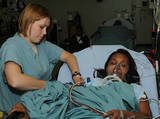Reversing Surgical Sterilization Is Not Easy
Reversing surgical sterilization in women is not as easy as one might hope for. When a woman has a tubal ligation, her fallopian tubes are either cut or permanently blocked to prevent future pregnancies. Reversing the tubal ligation requires a surgery under anesthetic as well as recovery time. This procedure is also not always covered under insurance, and could cost between six and seven thousand dollars.
If a woman has decided to have a tubal ligation procedure, she may at some point change her mind and decide that she wants more children. Women who were young at the time of the procedure, who have had a change in their marital status or who receive too little information about tubal ligation and its consequences, might all be good candidates for this procedure. Deciding to have a baby but not wanting to have in vitro fertilization is another possible reason for wanting to reverse surgical sterilization.

Are You A Candidate?
Not all women are good candidates for a reverse tubal ligation. Your doctor will discuss the risks with you and will take into consideration your age and weight, your overall health, the type of tubal ligation you had (cut or blocked), how much damage was done to the fallopian tubes during the surgery, and other fertility considerations.
While up to 75 percent of women who’ve had a reverse tubal ligation go on to become pregnant, there is a chance it won’t work. The chance of the procedure being successful depends on the health of your fallopian tubes, how much tube is left and if they were blocked or cauterized when they were sealed.
Before your actual reverse tubal ligation procedure, you may need to have a laparoscopy to determine that there is sufficient tubal length for reconnecting. This involves the doctor making a 1 centimeter incision in the navel through which a lighted instrument is passed to view the fallopian tubes. The doctor is then able to see how much tube is available.
During the tubal ligation reversal, your surgeon will make a 2 inch incision in your abdomen, and then expose your fallopian tubes, ovaries and uterus. With a microscope as an aid, the doctor will then remove any blockages from the fallopian tube, and reconnect it with the remaining fallopian tube using minuscule absorbable stitches.